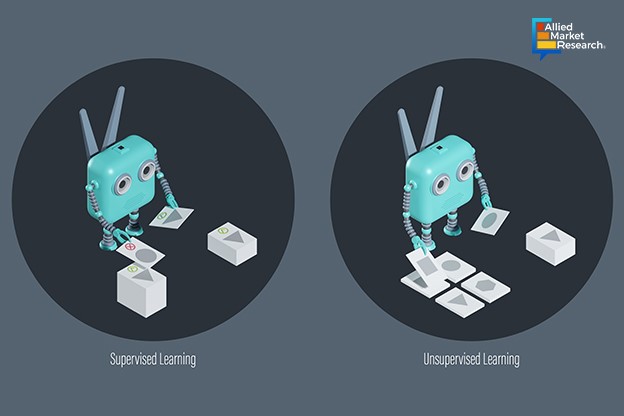Can the Use of Unsupervised Learning Enhance Your Business Expertise?

5 Feb
2024
Highlights:
- Introduction
- Unsupervised learning for anomaly detection and NLP
- Key techniques of unsupervised learning
- ChatGPT and unsupervised learning
In today’s tech world, artificial intelligence and machine learning are the two most rapidly evolving technologies that play a big role in boosting businesses and economies. Unsupervised learning is a branch of machine learning that uses machine learning algorithms to analyze huge datasets without any human intervention. The machine learning models try to find any kind of similarities, differences, patterns, and structures in datasets without explicit guidance. Such advanced models can turn data into insights and help businesses improve their efficiency, reduce costs, and aid them with informed decision-making. In this article, we will discuss the latest applications of unsupervised learning, reshaping industries with wide-scale opportunities.
Real-world applications of unsupervised learning that can empower your business capabilities
Today, many businesses are utilizing machine learning algorithms to foster their real-time translation, personalized recommendations, generate texts or images, and various other content. Apart from this, this advanced technology can help businesses with numerous real-time applications, some of which are discussed below:
As unsupervised learning algorithms can analyze large amounts of data, they play a significant role in detecting data points that are atypical in a dataset. This process of identifying atypical data is called anomaly detection. Therefore, these advanced algorithms are highly useful for the banking and financial sectors to detect fraud which has become a daily problem nowadays. With the use of advanced machine-learning models, banks can easily detect unauthorized transactions on an account. The models can take data from the credit card history of an individual which includes the number, type, time, and location of transactions, etc. Using all such data, the models can flag a fraudulent transaction by showing how the transaction stands out from the rest of the transactions. By receiving such warnings, banks can inform the cardholder to block the card to avoid further mis-happenings. These days, banks such as Bank of America have started using anomaly detection models to ensure their clients’ safety.
Another field, where these powerful models have shown their prominence is in various NLP (Natural Language Processing) applications. The latest unsupervised learning techniques such as Word2Vec and GloVe have transformed the field of NLP by capturing behavioral relationships between words. Such techniques can enable machines to understand the slight differences in words or texts and improve the performance of language-based applications such as sentiment analysis, chatbots, and language translation. These models can also promote various other NLP-based applications such as categorizing articles in news sections or speech recognition in conversational interfaces. Based on its growing applicability across various fields, the natural language processing segment is predicted to hold the highest share and generate a revenue of $10,437.8 million during 2022-2032.
What latest techniques of unsupervised learning can foster your business offerings?
In recent years, clustering has stood out as one of the promising techniques that can elevate various unsupervised learning-based applications. With the help of this technique, businesses can distinguish data and break it down into groups based on their similarities and differences. Clustering is one of the most popular machine learning approaches which is widely applicable in fraud detection, customer segmentation, image analysis, and many more. There exist several types of clustering based on the differentiating data which include exclusive clustering, overlapping clustering, hierarchical clustering, and probabilistic clustering.
Another useful technique is association which is a rule-based approach. This is used to reveal interesting relationships between data points in large datasets. This technique is widely used for analyzing retail baskets or transactional datasets to identify the popularity of certain items among individuals. The machine learning models used in such approaches can help identify customer purchasing patterns and previously hidden relationships that can help create cross-selling opportunities. Furthermore, these association rules can help organize medical datasets for clinical diagnoses. Using such machine learning models, doctors can identify the probability of a particular diagnosis by comparing relationships between different symptoms from past patient cases.
Does ChatGPT use unsupervised learning?
Machine learning models include both supervised and unsupervised learning. However, ChatGPT is using a combination of both models. By using supervised learning, the tool is trained to provide a large set of human-generated text such as online conversations or dialogue data. Through this approach, the tool learns the structure and style of the natural language. On the contrary, with unsupervised models, the tool can predict the next word in a sequence of text.
Currently, in the industries, ChatGPT and GPT-3 are widely used large language models that are trained by OpenAI. However, there exist some important differences between them. GPT-3 is a general-purpose language model designed to analyze a wide range of data and generate broader responses. It is significantly larger than ChatGPT, as it has 175 billion parameters compared to ChatGPT’s 2.6 billion parameters. This enables GPT-3 to generate more realistic and diverse text, promoting its applicability for resource-intensive use cases.
To conclude, the unsupervised learning industry is experiencing prominent growth due to the rise in accessibility of large and diverse datasets because of the rapid digitization and use of the internet across businesses. Moreover, the increasing development of AI and ML methods to process and analyze vast sets of data quickly will create extensive possibilities for the domain in the future.
To identify potential investment opportunities across various regions and gain more insights into the unsupervised learning market for your business expansion, feel free to contact our industry experts today!

Rosy Behera
Author's Bio- Rosy Behera holds a bachelor’s degree in Electrical and Electronics Engineering and now she is a content writer by profession. She loves to portray her thoughts and ideas with a nice command of words. Grabbing an audience with her creative write-ups is one of her biggest assets so far. Apart from writing, she is a certified “Odisi” dancer and has done Gardharva in Drawing, Painting, and Arts. She always explores new things through travel and is a big foodie.
Telehealth: Why Your Healthcare Business Needs to Adopt this Remote Health Monitoring Model?
Avenue: Entire Library membership of Allied Market Research Reports at your disposal
- Avenue is an innovative subscription-based online report database.
- Avail an online access to the entire library of syndicated reports on more than 2,000 niche industries and company profiles on more than 12,000 firms across 11 domains.
- A cost-effective model tailored for entrepreneurs, investors, and students & researchers at universities.
- Request customizations, suggest new reports, and avail analyst support as per your requirements.
- Get an access to the library of reports at any time from any device and anywhere.
Related Post
-
How are Submarine Cables Transforming Global Connectivity with Enhanced User Experience?
-
Endoscopy Procedures: Transformations in Techniques and Applications
-
AI-Powered Video Analytics: How the Product Actually Works for enterprises
-
Painting Robots: Transforming Precision Coating and Creative Applications
-
Innovations in Pharmacovigilance Systems Advancing Patient Safety
-
Understanding Edge Security: Keeping Data Safe Near the Source
-
Exploring the Use and Advancements of 3D Laser Scanners in Professional Applications
-
Reinforcing Industrial Controls with Smarter Tools and Training








